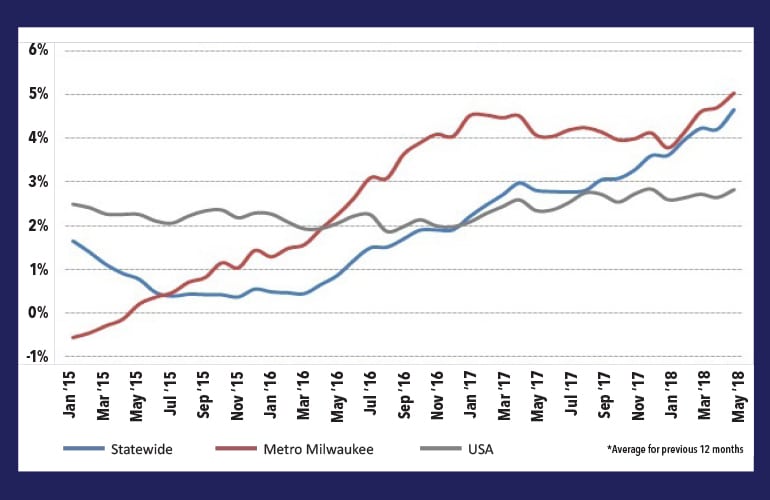The signs are everywhere. “Help wanted!” “Now hiring!” “Apply today!”
Employers throughout southeastern Wisconsin do not shy away from discussing how they are having a hard time finding the job candidates they need.
 While the lack of available talent has been a common complaint amongst businesses over the past several years, data from the U.S. Bureau of Labor Statistics suggest average wages for private sector employees in Wisconsin have increased faster than the United States as a whole over roughly the past two years.
While the lack of available talent has been a common complaint amongst businesses over the past several years, data from the U.S. Bureau of Labor Statistics suggest average wages for private sector employees in Wisconsin have increased faster than the United States as a whole over roughly the past two years.
“Before it was if you wouldn’t pay a competitive wage, you weren’t getting the quality people that you need,” said Mark Milan, marketing manager at Brookfield-based staffing firm QPS Employment Group.
At this point, he said, not paying competitive wages generally leads to not finding any workers at all.
Even as unemployment rates kept falling statewide, some employers may have been hesitant to raise wages. But Milan said pay is going up across the board.
“I’d say the majority (of employers), though, are coming around to paying more competitively,” he said.
In May, for example, the average weekly private sector wage in Wisconsin increased 6.4 percent from the same time in 2017, to $869.66. Nationwide, the increase was 3.1 percent, to $923.98. Account for inflation, and Wisconsin’s average wage was up $29.36 per week while the country’s was up just $2.27 per week.
Wage gains outpacing the national average are not a one-month phenomena for the state, either. Wisconsin averaged a year-over-year increase of 5.7 percent in the first five months of 2018, compared to 2.7 percent for the U.S. For all of 2017, the state averaged an increase of 3.6 percent, while the country averaged 2.8 percent.
Metro Milwaukee has seen a similar trend, with wages increasing 4.9 percent in May compared to the same time last year and averaging a 5.6 percent year-over-year increase in the first five months of 2018. The region also averaged an increase of 4.1 percent in both 2017 and 2016, outpacing U.S. wage growth both years.
The wage growth roughly coincides with when the state’s unemployment rate dipped below 4.5 percent. It has continued to trend downward, reaching a seasonally-adjusted 2.8 percent in April and May.
“We’re not anticipating, at least in the near future, that those numbers are going to get any higher,” Milan said. “We’re anticipating it’s still going to be a struggle to find workers.”
Milan said the one area where QPS has been able to find help is from the retail sector, which has been hit by the bankruptcy and subsequent store liquidations of Boston Store parent company Bon-Ton Stores Inc. and JCPenney’s decision to close its Wauwatosa distribution facility.
Monthly wage data is not available for the retail industry at the local level, but quarterly data from 2017 showed a 2.8 percent increase in average retail wages statewide and a 2.9 percent increase in metro Milwaukee. Average retail wages were up 2.7 percent statewide, according to the quarterly data from the Bureau of Labor Statistics.
Milan said QPS has found potential employees coming out of the retail setting can often transition to office work or cleaner manufacturing environments.
For the 12 months ending in May, Wisconsin’s trade, transportation and utilities sector has seen an average year-over-year increase in wages of 7.5 percent. The sector includes retail trade, but also brings in wholesale trade and other industries.
Average year-over-year wage increase

The largest increase statewide has been in financial activities, up an average of 8.1 percent. Professional and business activities wages increased an average of 3.8 percent, education and health services averaged a 3.1 percent increase, leisure and hospitality improved 2.1 percent, and construction averaged just a 1.9 percent increase.
Statewide, wages in the manufacturing sector increased an average of 4.7 percent, but pay for production workers was up just 2.9 percent.
In metro Milwaukee, however, production wages averaged an 11.9 percent increase and were up 8.5 percent within durable goods manufacturing. Private sector wages for the area, which included Milwaukee, Waukesha, Ozaukee and Washington counties, averaged a 5 percent increase.
“I don’t see wage increases stopping anytime soon,” Milan said, noting that not long ago, wage increases of 25 or 50 cents per hour were enough, but now some companies are adding $2 or $3 to base wages.
Sheboygan County, for example, saw wages increase 9 percent in May and averaged a 5.8 percent increase for the 12 months ending in May.
The one area that has seen a decrease in private sector wages is Racine County, which averaged a year-over-year decrease of 2.5 percent and was down 8.9 percent in May. Wages have declined for nine straight months.
The arrival of Foxconn Technology Group in Mount Pleasant could help end that streak, depending on how successful the company is in creating its planned 13,000 jobs in the coming years. Milan acknowledged Foxconn is still an unknown, not just for Racine and Kenosha counties, but for southeastern Wisconsin as a whole.

